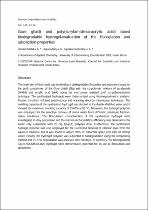 ResearchSpace
ResearchSpace
Gum ghatti and poly(acrylamide-co-acrylic acid) based biodegradable hydrogel-evaluation of the flocculation and adsorption properties
JavaScript is disabled for your browser. Some features of this site may not work without it.
- ResearchSpace
- →
- Research Publications/Outputs
- →
- Journal Articles
- →
- View Item
| dc.contributor.author |
Mittal, H

|
|
| dc.contributor.author |
Maity, Arjun

|
|
| dc.contributor.author |
Ray, SS

|
|
| dc.date.accessioned | 2016-06-27T08:39:25Z | |
| dc.date.available | 2016-06-27T08:39:25Z | |
| dc.date.issued | 2015-10 | |
| dc.identifier.citation | Mittal, H. Maity, A. and Ray, S.S. 2015. Gum ghatti and poly(acrylamide-co-acrylic acid) based biodegradable hydrogel-evaluation of the flocculation and adsorption properties. Polymer Degradation and Stability, 120, 42-52 | en_US |
| dc.identifier.issn | 0141-3910 | |
| dc.identifier.uri | http://www.sciencedirect.com/science/article/pii/S0141391015300197 | |
| dc.identifier.uri | http://hdl.handle.net/10204/8580 | |
| dc.description | Copyright: 2015 Elsevier. Due to copyright restrictions, the attached PDF file only contains the abstract of the full text item. For access to the full text item, please consult the publisher's website. The definitive version of the work is published in Polymer Degradation and Stability, 120, 42-52 | en_US |
| dc.description.abstract | The main aim of this study was to develop a biodegradable flocculent and adsorbent based on the graft co-polymer of the Gum ghatti (Gg) with the co-polymer mixture of acrylamide (AAM) and acrylic acid (AA) using the microwave assisted graft co-polymerization technique. The synthesized hydrogels were characterized using thermogravimetric analysis, Fourier transform infrared spectroscopy and scanning electron microscopy techniques. The swelling capacity of the synthesized hydrogel was studied in the double distilled water and it showed the maximum swelling capacity of 2547% at 50 °C. Moreover, the hydrogel polymer was employed for the selective removal of saline water from different petroleum fraction-saline emulsions. The flocculation characteristics of the synthesized hydrogel were investigated in clay suspension and the maximum flocculation efficiency was observed in the acidic clay suspension with 20 mg l(sup-1) polymer dose. Furthermore, the synthesized hydrogel polymer was also employed for the successful removal of cationic dyes from the aqueous solutions and it was found to adsorb 96% of malachite green and 99% of methyl violet. Finally, the hydrogel polymer was subjected to biodegradation using the composting method and 91.77% degradation was achieved after 60 days. In summary, the biodegradable Gg-cl-P(AAM-co-AA) hydrogel have demonstrated potential for its use as flocculants and absorbents. | en_US |
| dc.language.iso | en | en_US |
| dc.publisher | Elsevier | en_US |
| dc.relation.ispartofseries | Workflow;16391 | |
| dc.subject | Hydrogel polymer | en_US |
| dc.subject | Biodegradation | en_US |
| dc.subject | Adsorption | en_US |
| dc.subject | Flocculation | en_US |
| dc.title | Gum ghatti and poly(acrylamide-co-acrylic acid) based biodegradable hydrogel-evaluation of the flocculation and adsorption properties | en_US |
| dc.type | Article | en_US |
| dc.identifier.apacitation | Mittal, H., Maity, A., & Ray, S. (2015). Gum ghatti and poly(acrylamide-co-acrylic acid) based biodegradable hydrogel-evaluation of the flocculation and adsorption properties. http://hdl.handle.net/10204/8580 | en_ZA |
| dc.identifier.chicagocitation | Mittal, H, Arjun Maity, and SS Ray "Gum ghatti and poly(acrylamide-co-acrylic acid) based biodegradable hydrogel-evaluation of the flocculation and adsorption properties." (2015) http://hdl.handle.net/10204/8580 | en_ZA |
| dc.identifier.vancouvercitation | Mittal H, Maity A, Ray S. Gum ghatti and poly(acrylamide-co-acrylic acid) based biodegradable hydrogel-evaluation of the flocculation and adsorption properties. 2015; http://hdl.handle.net/10204/8580. | en_ZA |
| dc.identifier.ris | TY - Article AU - Mittal, H AU - Maity, Arjun AU - Ray, SS AB - The main aim of this study was to develop a biodegradable flocculent and adsorbent based on the graft co-polymer of the Gum ghatti (Gg) with the co-polymer mixture of acrylamide (AAM) and acrylic acid (AA) using the microwave assisted graft co-polymerization technique. The synthesized hydrogels were characterized using thermogravimetric analysis, Fourier transform infrared spectroscopy and scanning electron microscopy techniques. The swelling capacity of the synthesized hydrogel was studied in the double distilled water and it showed the maximum swelling capacity of 2547% at 50 °C. Moreover, the hydrogel polymer was employed for the selective removal of saline water from different petroleum fraction-saline emulsions. The flocculation characteristics of the synthesized hydrogel were investigated in clay suspension and the maximum flocculation efficiency was observed in the acidic clay suspension with 20 mg l(sup-1) polymer dose. Furthermore, the synthesized hydrogel polymer was also employed for the successful removal of cationic dyes from the aqueous solutions and it was found to adsorb 96% of malachite green and 99% of methyl violet. Finally, the hydrogel polymer was subjected to biodegradation using the composting method and 91.77% degradation was achieved after 60 days. In summary, the biodegradable Gg-cl-P(AAM-co-AA) hydrogel have demonstrated potential for its use as flocculants and absorbents. DA - 2015-10 DB - ResearchSpace DP - CSIR KW - Hydrogel polymer KW - Biodegradation KW - Adsorption KW - Flocculation LK - https://researchspace.csir.co.za PY - 2015 SM - 0141-3910 T1 - Gum ghatti and poly(acrylamide-co-acrylic acid) based biodegradable hydrogel-evaluation of the flocculation and adsorption properties TI - Gum ghatti and poly(acrylamide-co-acrylic acid) based biodegradable hydrogel-evaluation of the flocculation and adsorption properties UR - http://hdl.handle.net/10204/8580 ER - | en_ZA |





